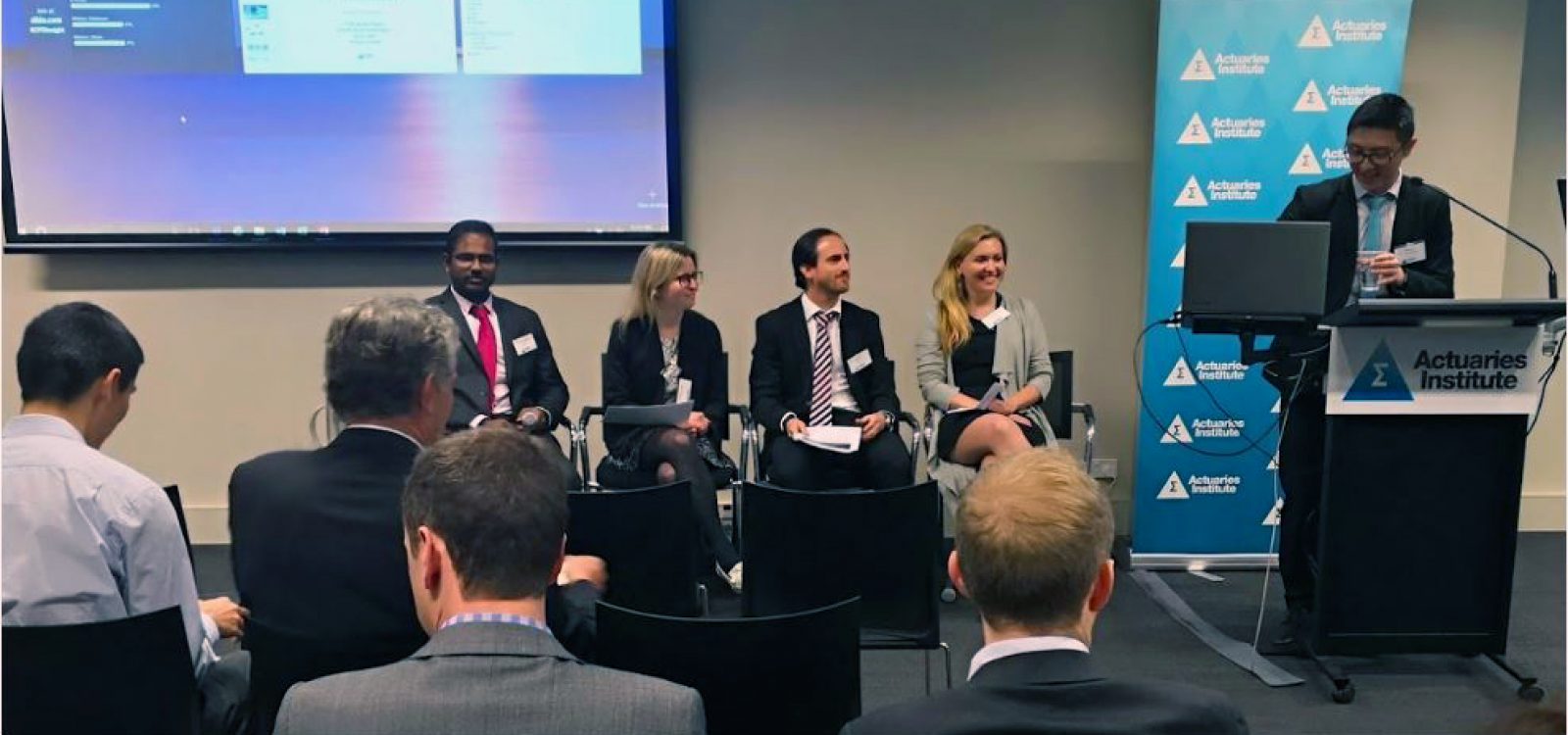
The Future of Life Insurance
The world is constantly evolving and changing, and that includes the insurance industry. What are these trends, what does this mean for insurers and actuaries alike, and what do we need to be aware of when relying on “robots”?
On the 27th September 2018, the Actuaries Institute held an Insights Session in Sydney to provide perspectives of what the future of life insurance might look like, and how the industry (and we working in it) must evolve in order to facilitate this transition and mitigate the risk of being left behind. The presenters in this session were Tetiana Maier from Oliver Wyman, Marc Mer & Kranthi Ram Nekkalapu from Deloitte and Catherine Edgar from Montoux. Marc Mer reports on the key ideas presented.
Future trend of insurance
Tetiana set the scene for the broader topic by emphasising that while the future is uncertain, the foundations for change are already established. However, the life industry has unfortunately lagged behind other industries in taking advantage of this opportunity. Trends in technology, regulation, human behaviour, society and the economy are all shaping industries. Technology has already changed everything, such as how we see the world, what we learn and how we live. This will impact the life insurance industry mainly through:
- Shifts in the risk profile (who/what is insured and how they are insured);
- Changing nature of the workforce (ageing populations, automation and the rise of the gig economy are changing both the insurance workforce as well as the need for protection); and
- The rise of new competitors (the industry that some may say has been unchallenged for so long is being disrupted, largely thanks to advances in technology / InsureTechs).
These shifts raise questions for insurers as to how they adapt their business models and protect their existence; whether it be an emphasis on being data driven or a technology company, or a more traditional emphasis on technical product development and underwriting. Either way a deeper focus on customer engagement is likely required.
The actuary of the future
Marc built on Tatiana’s platform of unprecedented change and opportunity in the midst of what he described as the Fourth Industrial Revolution. He highlighted a range of key disruptors that provide a burning platform for change, and then laid out the framework for the future of work across many industries and professions (covering what work we will do, who will do the work and where the work will be done). These disruptors have noticeably changed blue-collar jobs (replacing assembly lines with assembly machines), yet a white-collar office still looks largely the same as it did many years ago. Marc shared an image of what an actuary of the future – the “Exponential Actuary” – might look like at work, with humans and machines directly interacting.
There are a number of challenges that the insurance industry is facing (e.g. outdated systems, data constraints, emerging regulations, actuaries performing IT roles, etc), driving the need for actuaries to shift their focus from the operational into the more strategic activities. Actuaries need to adopt exponential technologies to become so-called exponential actuaries, automating or returning technology tasks back to IT, thus being in a position to proactively work on results and analysis and to support the development of insights-driven insurers.
Marc showed the audience what an actuarial process might look like a few years from now (shown below), highlighting that all of the technology to do this is already here:
 Source: Deloitte
Source: Deloitte
The shift in our work as actuaries will be towards higher cognitive and value-add activities. Today, some actuaries with substantial professional training and education focus a large proportion of their effort and time on lower cognitive areas. These are tedious, time consuming, and low cognitive. In future, more actuaries will release themselves from this operational low cognitive work, automating more of the computation work and spreading out our focus to the real value-added work (eg. ideation / hypothesizing, and application and decision-making), requiring a different level of skills.
The life insurer of the future
With the image of the future painted by Tetiana and Marc, Catherine shifted the conversation to the roadblocks the life insurance industry faces in getting there. As the industry continues to face significant headwinds in a number of areas (including sluggish growth and poor profitability), major challenges especially surround the customer:
- lack of customer centricity (in particular regarding product choice, purchase process, claims process)
- lack of knowledge/direct relationships with customers
- poor customer experience and therefore loyalty (further brought to light during the Royal Commission)
- changing customer expectations
Leveraging technological advancements and focussing on customer centricity can be game-changing and help insurers disrupt and transform these core challenges. The customer experience of the future is one that would always meet your insurance needs, help you get healthier, accept your risks and meet your budget. Having a customer experience that is streamlined, efficient, responsive and personalised should ultimately increase market penetration and retention.
Although the barriers to change for traditional insurers are manifold, change is already here and there is innovation happening in parts of the world. Companies such as Haven Life, ZhongAn Insurance and Lemonade embrace the technological “future” and serve as examples of where insurance companies could be heading.
In summary, the hypothesis is that the life insurer of the future is a customer-centric technology company with the capability to greatly outperform traditional life insurance companies. If we believe this to be the case, what does this mean for life insurers today and how do they move forward to face this challenge?
Advanced analytics to solve insurance problems
Kranthi brought the discussion home by sharing insights into how life actuaries can utilise algorithms to solve the problems presented by Catherine and the other speakers. Equally, algorithms can be black boxes and biased depending on the training sets provided. Thus, the use of interpretable algorithms is key to producing meaningful and unbiased results. Actuaries must be able to understand why an algorithm has accepted or rejected a decision. Putting a human in this loop and ensuring interpretability is key to help users develop trust in models.
Adding a further dimension, there is a trade-off required between accuracy and interpretability, as it is difficult to build algorithms with both these qualities. As an example, in most situations non-linear models provide better predictions than linear models; although the same cannot be said about their interpretability. So, there is a trade-off between accuracy and interpretability when choosing the right model.
 Source: Deloitte
Source: Deloitte
Kranthi synthesized that humans are intuitive beings and explanations come more naturally to us compared to complex calculations (taking inspiration from Dan Kahneman’s two systems in his book “Thinking Fast and Slow”). There is therefore a strong inclination towards using machines to build accurate algorithms with approximate explanations, and letting humans make a call on the performance of the algorithm. There could be exceptions, but this approach can be applied to most problems.
While technology is a significant driver of potential disruption, if we harness it properly, we can co-exist with machines to create the actuary of the future and the life insurer of the future.
CPD: Actuaries Institute Members can claim two CPD points for every hour of reading articles on Actuaries Digital.






